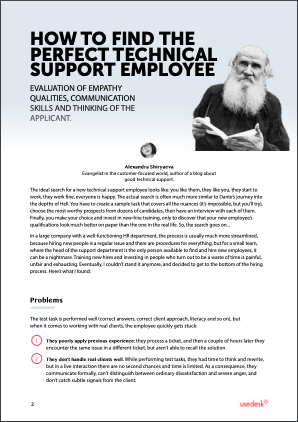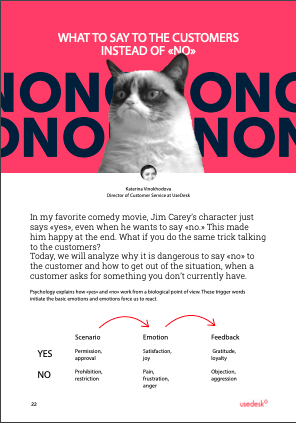Request a Demo
Send us a request for an online demonstration at the time that's convenient for you. We will give you an overview and answer any questions you may have about the system.
By clicking the button, you agree that you have read our Privacy Policy
INEXCUSABLE MISTAKES IN THE ORGANIZATION OF CUSTOMER SUPPORT

Katerina Vinokhodova
UseDesk Co-Owner
Today I, instead of Alex, will tell you meagrely and briefly (actually not) about the essence of the customer interaction and the way companies act to make this process outrageously bad. I will describe it in simple diagrams and words.
The reason to handle the customer requests
The reason to handle the customer requests When we were in the IIDF acceleration program, sales experts asked us why you spend so many resources on support? Why do companies respond to customers at all? Try not to answer and see what happens. Perhaps, nothing will happen.
We are brave and risky guys, so we tried to answer customers for one day instead of 1 hour as usual. The result: the next day we had to gain the upset customers' favor with discounts. Those clients who didn't excuse us just left immediately. Two companies acted this way.
Conclusion: it is necessary to answer clients' questions not to lose money.
However, the price of customer support for the company should not exceed the cost of customers who will leave the company without such support. Top performance means building the support that brings money, but this topic will be described by Sasha next time.
Also, we wrote a separate article about the cost of the bad service.
We are brave and risky guys, so we tried to answer customers for one day instead of 1 hour as usual. The result: the next day we had to gain the upset customers' favor with discounts. Those clients who didn't excuse us just left immediately. Two companies acted this way.
Conclusion: it is necessary to answer clients' questions not to lose money.
However, the price of customer support for the company should not exceed the cost of customers who will leave the company without such support. Top performance means building the support that brings money, but this topic will be described by Sasha next time.
Also, we wrote a separate article about the cost of the bad service.
Universal Request Processing Scheme
Universal Request Processing Scheme
The request processing consists of 5 stages. The task is simple: make sure that everything is fine at every stage. It sounds easy but in reality very few companies can do this. Here are the reasons.
1
Channels
You have clear and convenient channels of communication with clients on your website or somewhere else. You know how to record all messages from these channels and don't lose them.
2
Categorization and Prioritization
You sort the requests by topics and set the priority of processing.
3
Routing
Depending on the topics, you redirect the messages to the appropriate specialists.
4
Knowledge Base
The specialist who accepted the request has the correct and quickly available data to respond to the client.
5
Analytics
You see all the process statistics. You set KPIs, make sure that they are achieved, change the process in the bottle-neck, and check the figures again.
Communication Channels
You may think that I will write that the clients should contact you the way they feel comfortable. Actually, no. Customers should reach you the way to get qualified support without additional efforts.
So, provide the customers with such channels, where you can provide such support.
For example, we don't have telephone support because I have no idea how this type of approval looks like:
— I've got an error here, a red square…
— In which corner? To the left or the right?
It is much easier to write the letter with screenshots and receive the thoughtful and verified answer with screenshots, arrows, and video in a couple of hours.
Conclusion: the client doesn't need an additional channel if he can't receive help using it.
Social networks are a different story. We can't ignore them. Even though you would like to fence yourself off, the clients will still write something despicable (actually, quite reasonably in most cases). That's why it is necessary to monitor these requests and provide support right there.
99% mentions will be connected with an absolute failure; it's normal. Then you'll have to do smth with negative comments. Still, it is an excellent opportunity to practice solve conflicts with customers and gain some positive points to your karma.
So, provide the customers with such channels, where you can provide such support.
For example, we don't have telephone support because I have no idea how this type of approval looks like:
— I've got an error here, a red square…
— In which corner? To the left or the right?
It is much easier to write the letter with screenshots and receive the thoughtful and verified answer with screenshots, arrows, and video in a couple of hours.
Conclusion: the client doesn't need an additional channel if he can't receive help using it.
Social networks are a different story. We can't ignore them. Even though you would like to fence yourself off, the clients will still write something despicable (actually, quite reasonably in most cases). That's why it is necessary to monitor these requests and provide support right there.
99% mentions will be connected with an absolute failure; it's normal. Then you'll have to do smth with negative comments. Still, it is an excellent opportunity to practice solve conflicts with customers and gain some positive points to your karma.

Mistakes
1. Several e-mail addresses on the website. It is hell, please, don't do this. Unexpectedly, customers will write to the wrong address. Then the message will be lost inside the company as a result of multiple forwarding. The processing time will increase, and the price of the request will consistently grow.
2. There are many channels on the website that are useless. Sometimes it is not even clear where one should write, and nobody answers from the proposed channel — it's terrible—confused and abandoned.
3. Unrelated Systems: mail, chat, phone, social networks — everything is separate and has its tool. This scheme is suitable if you have up to 20 messages a day because many requests will be lost. Lost message = failed client.
4. Helpdesk that is not integrated with channels. A letter comes to Outlook; the employees copy it to the helpdesk. Then they leave their internal comment there but still respond in the mail client. I am sad when clients tell me such stories at meetings. This double work takes so much time, so many client requests are lost. No kidding, millions of rubles are lost.
2. There are many channels on the website that are useless. Sometimes it is not even clear where one should write, and nobody answers from the proposed channel — it's terrible—confused and abandoned.
3. Unrelated Systems: mail, chat, phone, social networks — everything is separate and has its tool. This scheme is suitable if you have up to 20 messages a day because many requests will be lost. Lost message = failed client.
4. Helpdesk that is not integrated with channels. A letter comes to Outlook; the employees copy it to the helpdesk. Then they leave their internal comment there but still respond in the mail client. I am sad when clients tell me such stories at meetings. This double work takes so much time, so many client requests are lost. No kidding, millions of rubles are lost.

Advice
Implement a multi-channel helpdesk system, use the monitoring system for mentions in social networks, and use a separate task-tracker. Everything automatically goes to the right place, and nothing is lost.
Assign an actual response time for every channel.
Assign an actual response time for every channel.

The options are simple and clear. Near them, you can see the average response time, which will help to set the priorities and will be decisive for someone.
Categorization and Prioritization
Customer requests are handled differently: 1, 2 lines, other departments' involvement, and partners. The faster we determine the parameters, which influence the entry's processing, the faster we will process the customer request. Divide and rule is the main principle of support.
Spoiler for the lazy ones: sort cases by topics and other essential parameters (client type, claim, or a question) and set priorities.
The reasons to do it:
1. Categorization will help route the request to the right specialist and clear out the queue without losing the answers' quality.
2. Count the reasons for the requests and send them to marketing experts, product specialists, and general directors to understand what is going on with the product, where, and why the company loses money.
Spoiler for the lazy ones: sort cases by topics and other essential parameters (client type, claim, or a question) and set priorities.
The reasons to do it:
1. Categorization will help route the request to the right specialist and clear out the queue without losing the answers' quality.
2. Count the reasons for the requests and send them to marketing experts, product specialists, and general directors to understand what is going on with the product, where, and why the company loses money.

Mistakes
1. Client-Side Categorization. In the contact form, the client is suggested to choose the reason for the list's request. That's good. It isn't good if there are 100500 variants, and you and the client understand these categories differently. General questions or Technical questions – what's the difference? It's easier to choose "Other" and not to waste time on it. Nobody will do the work for you.
2. Categorization according to the scheme "we keep it in mind": company employees "approximately" know what kind of questions clients usually ask, but don't record it. This doesn't work.
3. The division is too general. There is a little sense in it if you divide requests just for Questions, Claims, and Gratitude. You can partially solve the routing problem by doing this, but such a division is useless for statistics. It's impossible to see where the problems appear.
4. The categorization is too detailed. So, some categories are not used at all, and the level of detail is so high that it is hard to see the general picture.
2. Categorization according to the scheme "we keep it in mind": company employees "approximately" know what kind of questions clients usually ask, but don't record it. This doesn't work.
3. The division is too general. There is a little sense in it if you divide requests just for Questions, Claims, and Gratitude. You can partially solve the routing problem by doing this, but such a division is useless for statistics. It's impossible to see where the problems appear.
4. The categorization is too detailed. So, some categories are not used at all, and the level of detail is so high that it is hard to see the general picture.

Advice
1. The task of categorization should be divided between the client and the company. Important rule: it should be simple and almost unnoticeable for the client. You can add five categories maximum to the contact form or make it so that the request's destiny is clear according to the channel or website page from which it came from.
2. Automate the assignment of categories. Simple rules of helpdesk will help set the type automatically depending on the message's topic and text.
3. Add extra parameters to the requests for more detailed prioritization. The priority will be affected by the channel of the request (mail, social network, chat), client type (potential, current, or VIP), and so on. Anything that affects the process of the request processing should be recorded.
2. Automate the assignment of categories. Simple rules of helpdesk will help set the type automatically depending on the message's topic and text.
3. Add extra parameters to the requests for more detailed prioritization. The priority will be affected by the channel of the request (mail, social network, chat), client type (potential, current, or VIP), and so on. Anything that affects the process of the request processing should be recorded.
Routing
As soon as we have assigned the category to the request, we forward it to the person who can answer it. Here three aspects are important:
1. In which channel the request is forwarded.
2. In what form the request is forwarded
3. How quickly it is done.
1. In which channel the request is forwarded.
2. In what form the request is forwarded
3. How quickly it is done.

Mistakes
1. Send the request over the disparate channels:
The result: requests are lost.
2. Send requests without the context of the client's message, without the necessary data. As a result, the request is returned to the second round to clarify the details. The processing time increases; everybody suffers.
3. If priorities and categories are not set, the requests stay unprocessed until their turn comes. So, they will be transferred to the specialists only when the client's patience will run out.
4. Hire a particular team member who deals only with routing the requests.
- by feet to the next room
- by phone – and nothing is recorded on the other side
- in Skype, WhatsApp, mail – without a particular order
- on paper – forests suffer, and piece disappears in a trash bin
The result: requests are lost.
2. Send requests without the context of the client's message, without the necessary data. As a result, the request is returned to the second round to clarify the details. The processing time increases; everybody suffers.
3. If priorities and categories are not set, the requests stay unprocessed until their turn comes. So, they will be transferred to the specialists only when the client's patience will run out.
4. Hire a particular team member who deals only with routing the requests.

Advice
1. Automate routing depending on the category of the request. Rules in helpdesk will help to do this.
2. Work in a single interface according to the same order. It can be helpdesk with internal comments or Slack, JIRA, Asana, Telegram – it doesn't matter. The order of the requests forwarding should be assigned and unquestioned. No notes on computer and calls without recording a specific task in writing.
3. Gather everyone in one helpdesk interface is a hard work but we solved this problem. The notification of the ticket appointment comes directly to the e-mail, and the employee can answer the comment right from the e-mail without going to Usedesk. The employee's answer is automatically added to the ticket as an internal comment. The chain of the solution is kept in one place. Hooray.
2. Work in a single interface according to the same order. It can be helpdesk with internal comments or Slack, JIRA, Asana, Telegram – it doesn't matter. The order of the requests forwarding should be assigned and unquestioned. No notes on computer and calls without recording a specific task in writing.
3. Gather everyone in one helpdesk interface is a hard work but we solved this problem. The notification of the ticket appointment comes directly to the e-mail, and the employee can answer the comment right from the e-mail without going to Usedesk. The employee's answer is automatically added to the ticket as an internal comment. The chain of the solution is kept in one place. Hooray.

Depending on the incoming parameters, the automation rules send the request to the right specialist.
Knowledge Base
By the knowledge base, I mean all the information needed to solve the client's request. Knowledge of the product, procedures, customers – all of them must be stored centrally and easily accessible to support specialists.

Mistakes
1. All answers are taken from the team member's head, and knowledge is passed on to beginners orally. It works for up to two people in a company, but as soon as the time comes to hire new employees or change processes, it will hurt both you and your customers.
2. Employees keep personal instructions and templates in Word and Notepad. The management doesn't have a tool to keep track of what their employees answer. It turns out that the client receives outdated or incorrect information.
3. There is no single history of customer requests. This leads to the fact that the requests are not solved initially, and clients request again and again. The company spends more money on processing repeated requests.
2. Employees keep personal instructions and templates in Word and Notepad. The management doesn't have a tool to keep track of what their employees answer. It turns out that the client receives outdated or incorrect information.
3. There is no single history of customer requests. This leads to the fact that the requests are not solved initially, and clients request again and again. The company spends more money on processing repeated requests.

Advice
1. Use response templates and knowledge base in the helpdesk. All data for the replies are stored and edited centrally; errors are impossible.
2. Take into account the history of previous communication with the customer. It isn't good if only one manager knows about the client's situation. It is useful when a team member can conduct a dialogue knowing the details.
3. Integrate helpdesk with CRM so that employees could see more information about the client – their orders, payments, bonuses. This will shorten the processing time of the request.
2. Take into account the history of previous communication with the customer. It isn't good if only one manager knows about the client's situation. It is useful when a team member can conduct a dialogue knowing the details.
3. Integrate helpdesk with CRM so that employees could see more information about the client – their orders, payments, bonuses. This will shorten the processing time of the request.

The speed of the response is higher if an employee sees the customer card with their history and contacts.
Statistics
The main mistake of the companies is that they don't count anything. You have to save everything, digitalize all customer communication in all directions because the main and the most critical information you have is in the support department. The algorithm for working with statistics is simple:
Assign KPIs related to business → View statistics → Analyze bottle-necks → Change processes to achieve the targeted KPIs.
Assign KPIs related to business → View statistics → Analyze bottle-necks → Change processes to achieve the targeted KPIs.
Total
For high-quality request processing, use the right tools to build the right processes at every stage.

You have read the entire article, not frightened, and ready to improve your support, right? Great, we will help you. Email us at support@usedesk.com with the subject "I want the super-support and discount," and we will show you Usedesk and give a 30% discount for the annual rate.
Share with your colleagues:
Did you like this article?
Error get alias
We know a lot about customer service
Once every two weeks, we will send exciting and valuable materials about customer service - articles, cases, and system updates. Do you mind?







